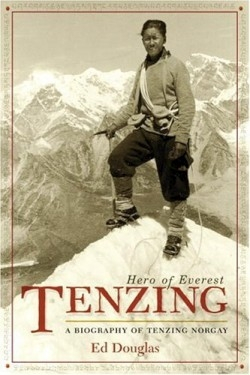Tenzing
Hero of Everest
After a lifetime in the limelight, Sir Edmund Hillary, the first person to climb Mount Everest, has kept the publicity machine rolling lately by appearing in a television commercial promoting an all-terrain vehicle. But never fully sharing in that prestige or fame was Tenzing Norgay, the Sherpa guide responsible for getting Hillary to the summit in 1953. Tenzing and his fellow guides spent years of arduous, dangerous work for low wages, catering to an often cocky, arrogant group of rich adventurers.
In this biography of Tenzing, the author paints a graphic and often grim portrait of this Sherpa and the whole Himalayan mountain guide culture. Frostbite was a constant problem, and Sherpas feared losing their toes and fingers, which would lead to the loss of their ability to do their jobs. Douglas, editor of the Alpine Journal, the oldest mountaineering publication in the world, has spent two decades on expeditions to the world’s most challenging peaks.
This biography includes personal interviews with those who knew Tenzing well and climbed with him. Its publication coincides with the 50th anniversary of the historic climb by Tenzing and Hillary.
During Tenzing’s early life in a Tibetan valley near Everest, mountaineering expeditions in that part of the world were still in an embryonic stage. Most local, skilled climbers did not see the commercial potential for these expeditions. Tenzing, however, realized that he could create a career for himself as a leader for Westerners. He consciously made an effort to professionalize the role and elevate the term “Sherpa” to mean more than day laborer. The book describes how Tenzing gained a following for himself among the other Sherpas, and with Western climbers, by acting like a leader and dressing the part. Instead of wearing hand-me-downs from clients, Tenzing created his own sharp-looking uniform.
While the Hillary-Tenzing conquest of Everest holds the potential marquee value for this book, the author concentrates on the culture of the Sherpa and Tenzing’s often conflicted life, as he achieved his own modicum of fame from the mountaineering community. Douglas presents a gloves-off look at the complex relationships between Sherpas and their clients. The Swiss were viewed as the best, since they treated the Sherpas as equals, usually rewarding them with the finest equipment after the quest. The English gentry, however, were frequently a different story. Tenzing once was reluctant to join an English expedition, worrying that these aloof individuals would treat him as servant.
Mountaineering is rapidly gaining in popularity as the sport becomes more affordable. This intoxicating book should be required reading for the uninitiated who will soon be putting their lives in the hands of these guides. They may come to appreciate summitting all that much more.
Reviewed by
Karl Kunkel
Disclosure: This article is not an endorsement, but a review. The publisher of this book provided free copies of the book to have their book reviewed by a professional reviewer. No fee was paid by the publisher for this review. Foreword Reviews only recommends books that we love. Foreword Magazine, Inc. is disclosing this in accordance with the Federal Trade Commission’s 16 CFR, Part 255.

